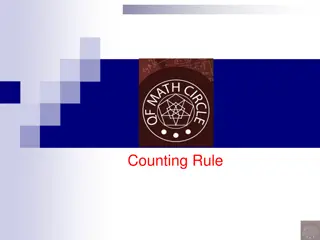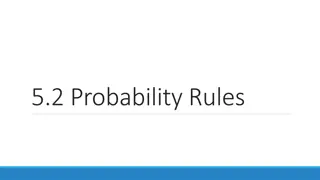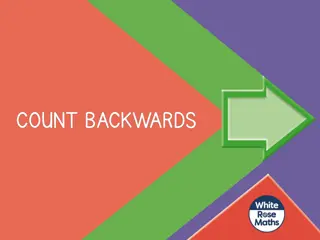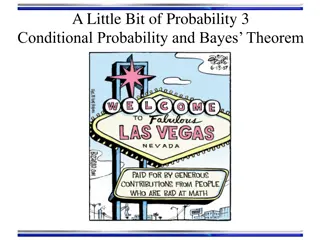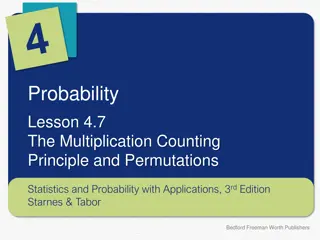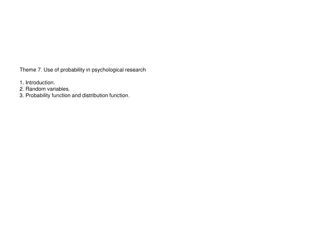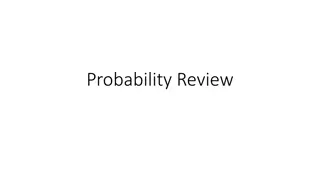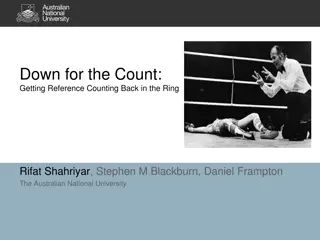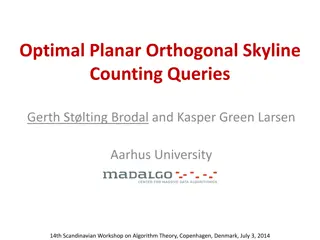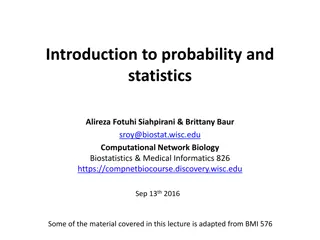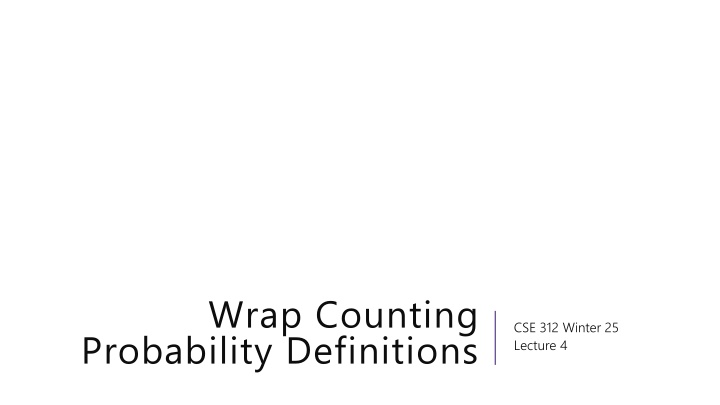
Counting Rules, Probability Definitions, and Pigeonhole Principle Overview
Explore counting rules, formal definitions of probability, and examples of the pigeonhole principle in action. Learn how to apply these principles and tips for practical use in problem-solving scenarios.
Download Presentation

Please find below an Image/Link to download the presentation.
The content on the website is provided AS IS for your information and personal use only. It may not be sold, licensed, or shared on other websites without obtaining consent from the author. If you encounter any issues during the download, it is possible that the publisher has removed the file from their server.
You are allowed to download the files provided on this website for personal or commercial use, subject to the condition that they are used lawfully. All files are the property of their respective owners.
The content on the website is provided AS IS for your information and personal use only. It may not be sold, licensed, or shared on other websites without obtaining consent from the author.
E N D
Presentation Transcript
Wrap Counting Probability Definitions CSE 312 Winter 25 Lecture 4
Outline Today Two More Rules Formal Definitions of Probability
Pigeonhole Principle If you have 5 pigeons, and place them into 4 holes, then At least two pigeons are in the same hole.
Pigeonhole Principle If you have 5 pigeons, and place them into 4 holes, then At least At least two pigeons are in the same hole. It might be more than two.
Strong Pigeonhole Principle If you have ? pigeons and ? pigeonholes, then there is at least one pigeonhole that has at least ? ?pigeons. ? is the ceiling of ? (it means always round up, 1.1 = 2, 1 = 1).
An example If you have to take 10 classes, and have 3 quarters to take them in, then Pigeons: The classes to take Pigeonholes: The quarter Mapping: Which quarter you take the class in. Applying the (generalized) pigeonhole principle, there is at least one quarter where you take at least 3 10 = 4 courses.
Practical Tips When the pigeonhole principle is the right tool, it s usually the first thing you d think of or the absolute last thing you d think of. For really really tricky ones, we ll warn you in advance that it s the right method (you ll see one in the section handout). When applying the principle, say: What are the pigeons What are the pigeonholes How do you map from pigeons to pigeonholes Look for a set you re trying to divide into groups, where collisions would help you somehow.
One More Counting Rule You re going to buy one-dozen donuts (i.e., 12 donuts) There are chocolate, strawberry, coconut, blueberry, and lemon (i.e. five types) How many different donut boxes can you buy? Consider two boxes the same if they contain the same number of every kind of donut (order doesn t matter)
One More Counting Rule You re going to buy one-dozen donuts (i.e., 12 donuts) There are chocolate, strawberry, coconut, blueberry, and lemon (i.e. five types) Put donuts in order by type, then put dividers between the types. Counting the number of ways to place dividers instead.
Explanation 1 Think of it as a string. There are 12 + (5 1) characters. But 12 are the donut character (identical) and 4 are the divider character (identical). So? 16! 12!4! i.e., 16 4
Placing Dividers Place a divider how many possible locations are there? 13 before donut 1, before 2, , before donut 12, after donut 12.
Placing Dividers Place a divider how many possible locations are there? 13 before donut 1, before 2, , before donut 12, after donut 12. Place the second divider, how many possible locations are there? 14 one of the previous spots was split ( before and after the last divider)
Placing Dividers Place a divider how many possible locations are there? 13 before donut 1, before 2, , before donut 12, after donut 12. Place the second divider, how many possible locations are there? 14 one of the previous spots was split ( before and after the first divider) In general, placing divider ? has 12 + ? possible locations.
Wrapping Up We had 12 donuts, how many dividers do we need? 4 (to divide into 5 groups) Count so far: 13 14 15 16 Are we done?
Wrapping Up Count so far: 13 14 15 16 This count treats all dividers as different they re not! Divide by 4!. For ? donuts of ? types ?+1 ?+2 ?+? 1 (? 1)! That s a combination! ?+? 1 ? 1
Wrapping Up ?+? 1 ? 1 We wrote down a string consisting of ? ? + ? 1 characters, ? donuts are identical, ? 1 dividers are identical, so divide by the rearrangements (like we did for SEATTLE). and ? 1
In General To pick ? objects from ?groups (where order doesn t matter and every element of each group is indistinguishable), use the formula: ? + ? 1 ? 1 The counting technique we did is often called stars and bars using a star instead of a donut shape, and calling the dividers bars
Weve seen lots of ways to count Sum rule (split into disjoint sets) Product rule (use a sequential process) Combinations (order doesn t matter) Permutations (order does matter) Principle of Inclusion-Exclusion Complementary Counting Stars and Bars ?+? 1 ? 1 Niche Rules (useful in very specific circumstances) Binomial Theorem Pigeonhole Principle
Extra Practice Extra video coming later this week
Practice How do we know which rule to apply? With practice you can pick out patterns for which ones might be plausible. But if as you re working you realize things are getting out of control, put it aside and try something different.
Cards A standard deck of cards has 52 cards. Each card has a suit diamonds , hearts , clubs , spades and a value (Ace,2,3,4,5,6,7,8,9,10,Jack,Queen, King). A 5-card-hand is a set of 5 cards How many five-card flushes are there? a flush is a hand of cards all of the same suit.
Cards How many five-card flushes are there? a flush is a hand of cards all of the same suit. Way 1: How can I describe a flush? Which suit it is, and which values: 4 1 13 5
Cards Way 2: Pretend order matters. The first card can be anything, After that, you ll have 12 options (the remaining cards of the suit), then 11, Then divide by 5!, since order isn t supposed to matter. 52 12 11 10 9 5! This is the same number as what we got on the last slide!
A Solution with a Problem You wish to count the number of 5-card hands with at least 3 aces. There are 4 Aces (and 48 non aces) 4 3 Choose the three aces. Then of the 49 remaining cards (the last ace is allowed as well, because we re allowed to have all 4) 49 2 What s wrong with this calculation? What s the right answer? Fill out the poll everywhere so Robbie knows how long to explain Go to pollev.com/robbie
A Solution with a Problem For a hand, there should be exactly one set of choices in the sequential process that gets us there. {A , A , A } {A , K } And {A , A , A }, {A , K } Are two different choices of the process, but they lead to the same hand!
A Solution with a Problem We could count exactly which hands appear more than once, and how many times each appears and compensate for it. See the extra slides at the end. An easier solution is to try again The problem was trying to account for the at least come up with disjoint sets and count separately. 4 3 If there are exactly 3 aces, we choose which 3 of the 4, then choose which 2 cards among the 48 non-aces. If all 4 aces appear, then one of the remaining 48 cards finishes the hand. Applying the sum rule completes the calculation. 48 2 4 4 48 1 +
Takeaway It s hard to count sets where one of the conditions is at least X You usually need to break those conditions up into disjoint sets and use the sum rule.
Another Problem You have to choose 8 pieces of fruit. There are apples, oranges, and bananas. You need to pick at most 2 apples and at least 1 banana. How many sets of fruit can you choose?
Another Problem You have to choose 8 pieces of fruit. There are apples, oranges, and bananas. You need to pick at most 2 apples and at least 1 banana. How many sets of fruit can you choose? Divide into cases based on number of apples: 0 apples: 1 to 8 bananas possible (8 options) 1 apple: 1 to 7 bananas possible (7 options) 2 apples: 1 to 6 bananas possible (6 options) 21 total (by sum rule)
Another Problem You have to choose 8 pieces of fruit. There are apples, oranges, and bananas. You need to pick at most 2 apples and at least 1 banana. How many sets of fruit can you choose? Pick out your first banana. Problem is now to pick 7 fruits (at most 2 apples, allowed to take apples oranges and bananas) Ignore apple restriction, and subtract off when too many apples: Ignore restriction: 7+3 1 3 1 3 apples, 4+3 1 3 1 Total: 9 2 (choose 3 apples first, pick 4 remaining) 6 2= 36 15 = 21
Takeaways For donut-counting style problems with twists , it sometimes helps to just throw the first few in the box to get a problem that is exactly in the donut-counting framework. When you can do a problem two very very different ways and get the same answer, you get much more confident in the answer.
Which Tool Do I Use? Pick ? things from universe of ? (? ?) Order does NOT matter Repetition is NOT allowed Combinations ? ? Repetition IS allowed Stars and Bars ?! ? + ? 1 ? 1 = ?! ? ? ! Be careful which is ? and which is ?. This is ? donuts from ? flavors. Product rule ? ? ? = ?? Order does matter Permutations ?! ? ?,? = ? ? ! This is NOT sometimes it s a completely different tool. But a sign where to start. NOT foolproof! Sometimes you need a twist on the formula;
A Solution with a Problem You wish to count the number of 5-card hands with at least 3 aces. There are 4 Aces (and 48 non aces) 4 3 Choose the three aces. Then of the 49 remaining cards (the last ace is allowed as well, because we re allowed to have all 4) 49 2 What s wrong with this calculation?
When do we overcount? If there are exactly 4 Aces in the hand, then we count the hand 4 different times (once for each ace as an extra one: {A , A , A }, {A , ?} {A , A , A }, {A , ?} {A , A , A }, {A , ?} {A , A , A }, {A , ?}
How much do we overcount? There are 48 such hands (one for every card that could be ? on the last slide) So we ve counted 3 48processes that shouldn t count. That would give a corrected total of 4 This is the same number as we got during lecture with our other counting. 49 2 3 3 48
Probability Probability is a way of quantifying When more than one outcome is possible, quantifying our uncertainty. To have real-world examples, we ll need to start with some foundational processes that we re going to assert exist We can flip a coin, and each face is equally likely to come up We can roll a die, and every number is equally likely to come up We can shuffle a deck of cards so that every ordering is equally likely.
Sample Space Sample Space A sample space is the set of all possible outcomes of an experiment. outcome is our word for a single element of . Examples: For a single coin flip, = {?,?} For a series of two coin flips, = {??,??,??,??} For rolling a (normal) die: = {1,2,3,4,5,6}
Events Event An event ? is a subset of possible outcomes (i.e. a subset of ?) Examples: Get at least one head among two coin flips (? = {??,??,??}) Get an even number on a die-roll (? = {2,4,6}).
Examples D2=1 D2=1 D2=2 D2=2 D2=3 D2=3 D2=4 D2=4 I roll a blue 4-sided die and a red 4-sided die. D1=1 D1=1 (1,1) (1,2) (1,3) (1,4) The table contains the sample space. D1=2 D1=2 (2,1) (2,2) (2,3) (2,4) D1=3 D1=3 (3,1) (3,2) (3,3) (3,4) The event the sum of the dice is even is in gold The event the blue die is 1 is in green D1=4 D1=4 (4,1) (4,2) (4,3) (4,4)
Probability Probability A probability is a number between 0 and 1 describing how likely a particular outcome is. We ll define a function : [0,1] i.e. takes an element of as input and outputs the probability of the outcome. We ll also use Pr[?], ?(?) as notation.
Example Imagine we toss one coin. Our sample space = {?,?} What do you want to be?
Example Imagine we toss one coin. Our sample space = {?,?} What do you want to be? It depends on what we want to model If the coin is fair ? = ? =1 But we also might have a biased coin: ? = .85, ? = 0.15. 2.
Probability Space Probability Space A (discrete) probability space is a pair (?, ) where: ? is the sample space :? [?,?] is the probability measure. satisfies: ? ? for all ? ? ? (?) = ? If ?,? ? and ? ? = then ? ? = ? + (?)
Probability Space Flip a fair coin and roll a fair (6-sided) die. = ?,? {1,2,3,4,5,6} 1 12 for every ? ? = Is this a valid probability space? takes in elements of and outputs numbers between 0 and 1 ? ? = 1.
Measure = ?,? {1,2,3,4,5,6} 1 12 for every ? ? = So what s the probability of seeing a heads? Seeing heads isn t an element of the sample space! Define ? = ? E (?)
Probability Space Probability Space A (discrete) probability space is a pair (?, ) where: ? is the sample space :? [?,?] is the probability measure. satisfies: ? ? for all ? ? ? (?) = ? If ?,? ? and ? ? = then ? ? = ? + (?)
Uniform Probability Space The most common probability measure is the uniform the uniform measure, for every event ? ? . Let your sample space be all possible outcomes of a sequence of 100 coin tosses. Assign the uniform measure to this sample space. What is the probability of the event there are exactly 50 heads? A. 100 B. 1/101 C. 1/2 D. 1/250 E. There is not enough information in this problem. uniform probability measure. In ? = 50/2100

